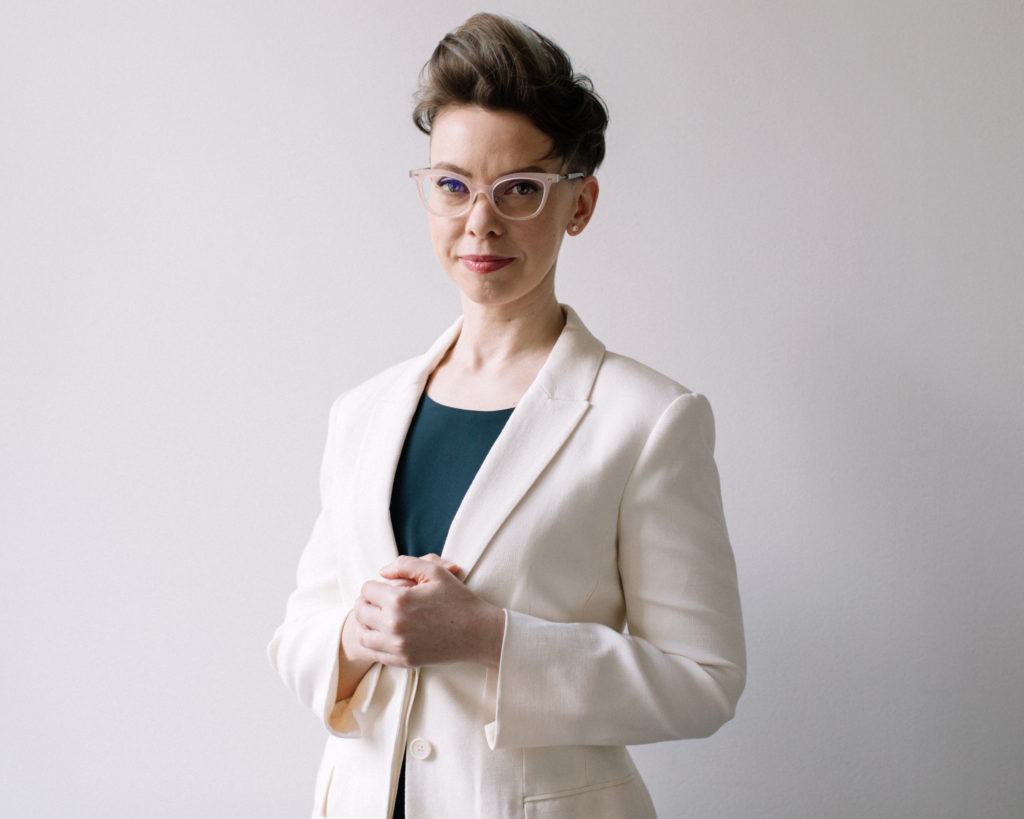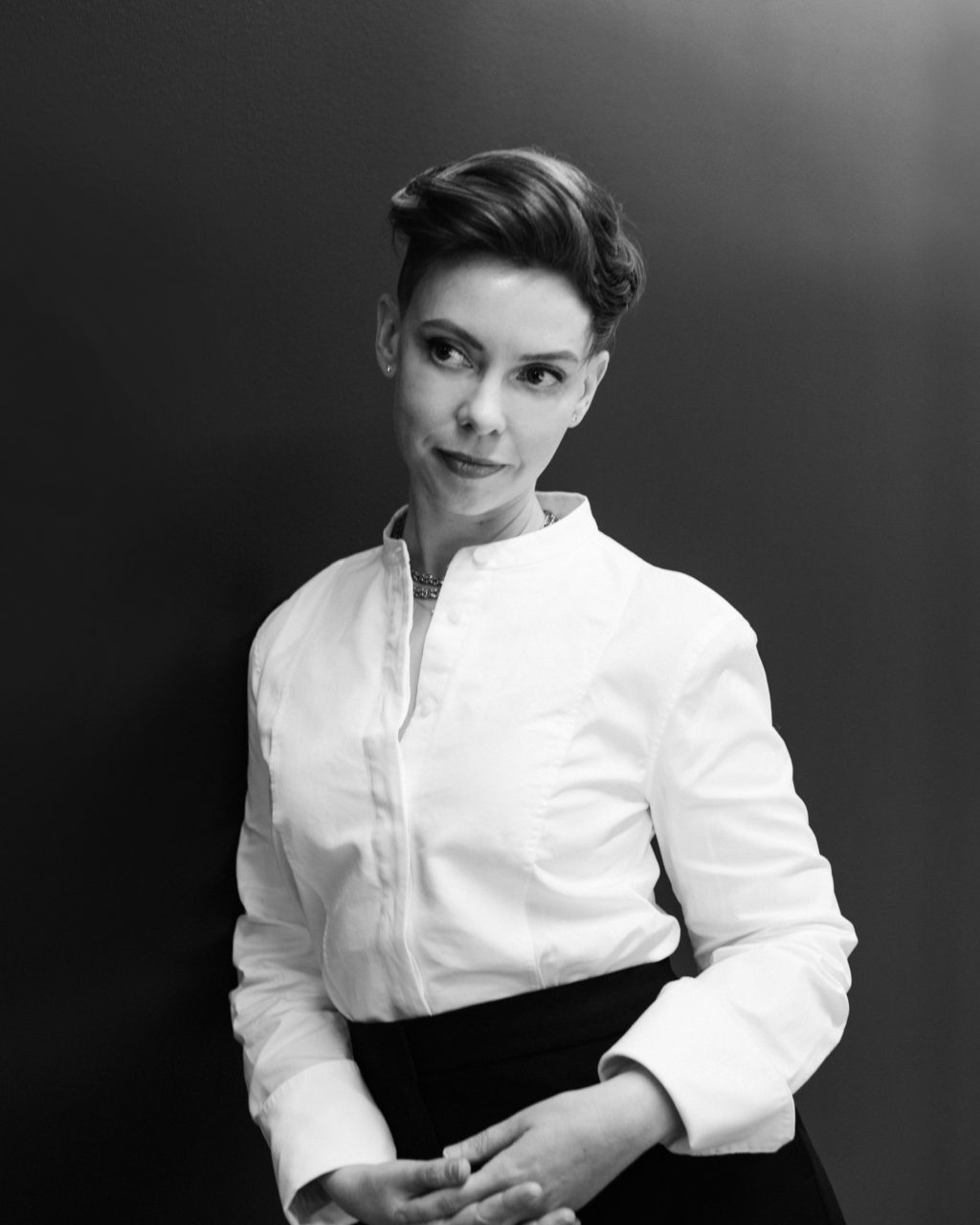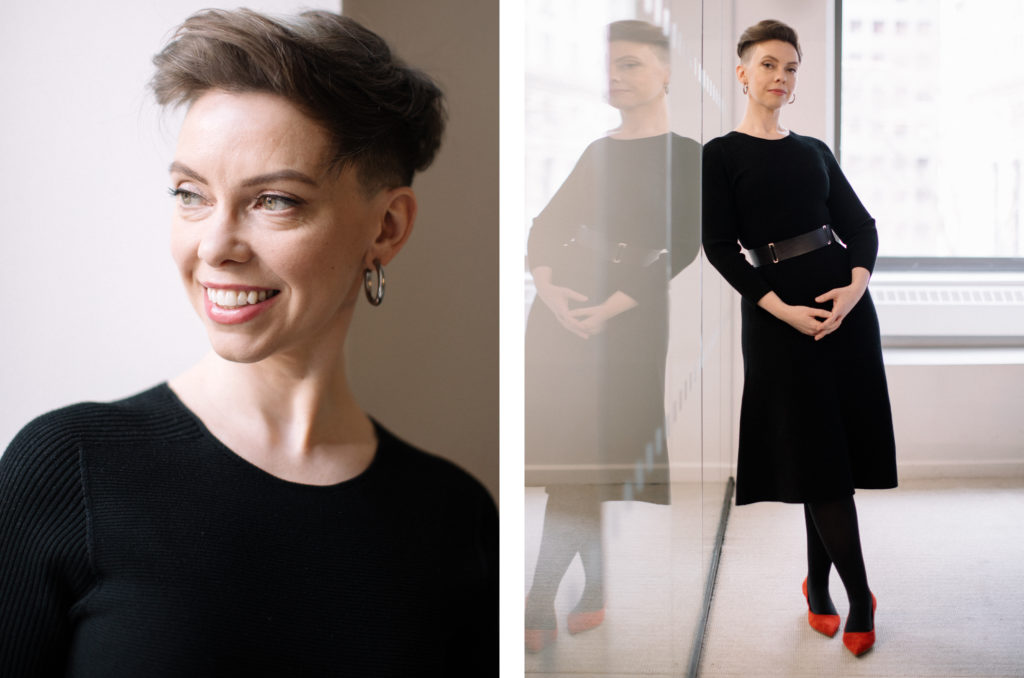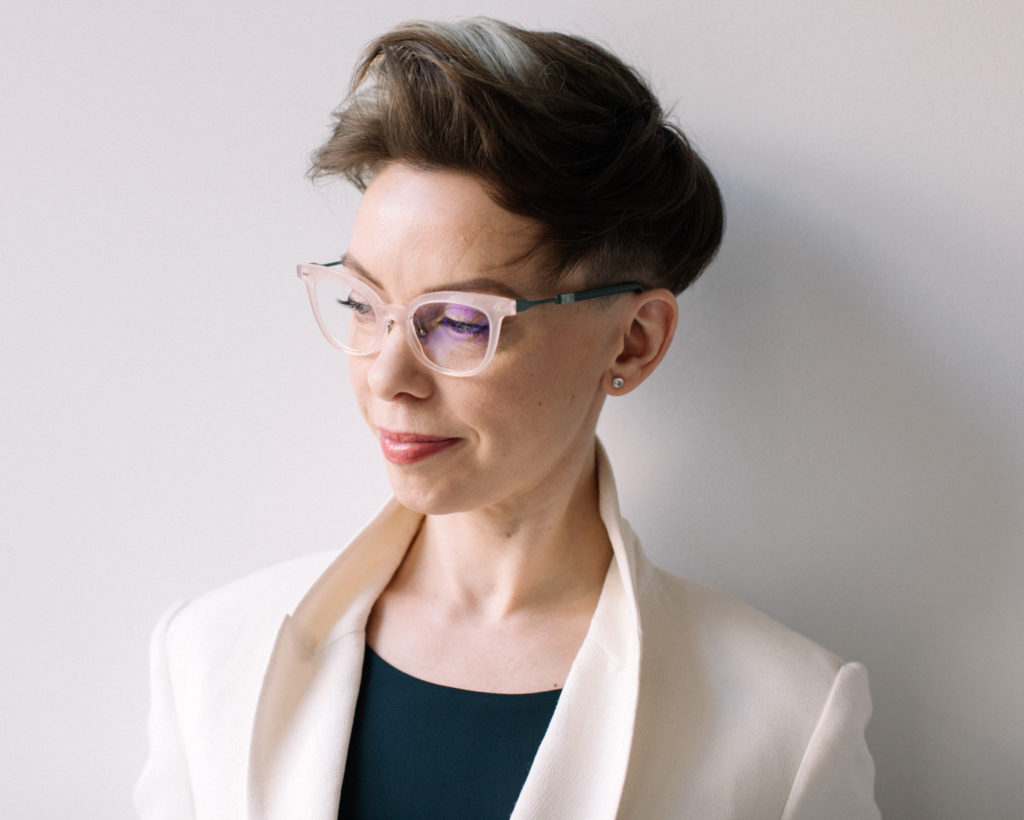Georgia Lee Hussey Explains Why Money Is An Emotional Investment
April 26, 2019 | Filed in: Woman of the Week
If you had told a young Georgia Lee Hussey that she would someday start a wealth management firm, she would have laughed. Raised in a family that struggled with money, she lived on a shoestring for much of her life, especially when she was starting her career as an artist. But when a subprime mortgage sent her into crisis at age 27, she reexamined her relationship to money. To her own surprise, she fell in love with finance and now serves as CEO of Modernist Financial, which helps progressive people plan and manage their wealth. (NB: You need to invest a minimum of $1M to become a client, so start saving!) Below, we chat with Georgia Lee about gender performance, emotional investing, and taking charge of your financial story.

Georgia wears the Babette jacket, the Nanette dress, and the Bezel earrings.
I HAD A PRETTY CHAOTIC CHILDHOOD. My dad was out of the picture by the time I was six, and my mom had addiction issues and undiagnosed mental illness. But she was really committed to giving me the best possible education—she sometimes worked three or four jobs to do that. I went to an all-girls Catholic school for twelve years, which was the best thing that ever happened to me. It created the stability I needed, and it framed the way I see the world.
I REMEMBER THE FIRST TIME I WAS IN A CLASSROOM WITH A BOY, and I was like, “This is weird.” It was during a summer program that I did in high school, and I quickly learned that all the things I’d heard about coed education were true. All the girls were sitting in the back, not raising their hands; the men were taking up all the space. Seeing that in action made me so grateful for my all-girls education. Growing up, no one had ever made me believe I wasn’t equal, and that shaped the way I’ve developed my voice.
I GOT A SCHOLARSHIP TO SARAH LAWRENCE COLLEGE, which I used to study installation sculpture and creative writing. I worked in a variety of media—welding, glass-blowing, wax casting, anything that involved fire. Those were typically male-dominated media because they’re so physical and embodied. I had this, “F*ck you! I can do this too!” kind of attitude. Give me a blowtorch, and I was a happy girl.

Georgia wears the Holley dress and the Tristan earrings.
I FELT SAFE, APPRECIATED, AND SUPPORTED at Sarah Lawrence. I identify as queer, and it felt like I was truly among peers for the first time in my life. I had tried to start a gay-queer alliance in my Catholic school, but that was 1996, and the nuns were having none of it. So I loved being in college with other weirdos who were ambitious and strange and super smart.
I PLANNED TO BE A PROFESSIONAL ARTIST, but it wasn’t until the week before graduation that the financial reality of that hit me. I had student loans, and I couldn’t ask my family for money, so I moved to Portland, Oregon, to figure out what to do. At first, I just rode my bicycle around and drank lemon drops all day at this lesbian bar called The E Room. Eventually, I got a day job as a checkout girl at a surplus warehouse called Wacky Willy’s. It was kind of boring, so my colleague Seann and I started a little gallery in the corner of the warehouse. By the end of the year, we were putting on shows that were attended by 500 people.
I MOVED TO NEW YORK FOR A WOMAN that I was in love with, which did not work out. New York eats my soul alive, and a lot of issues from my childhood were coming home to roost. I escaped to Europe with $1,200, and I was like, “I’m just going to figure it out.” I was 23, and I spent the next few months at artist residencies in the Czech Republic and Scotland. It was a great way to get away from other people so that I could have a breakdown—and make a hell of a lot of art.

Georgia wears the Penelope top, the Tinsley trouser, the Bezel earrings, and the Valentina necklace.
WHEN I WAS 27, I MOVED BACK TO PORTLAND AND DECIDED TO BUY A HOUSE because I thought that’s what adults did. This was 2006, and I ended up getting a subprime mortgage that quickly became a huge burden. I realized I had no idea how to budget, so I started reading everything I could about money—and I became fascinated. I decided to get certified as a financial planner, and I was especially interested in behavioral finance. There’s a lot of research that shows that our decisions, financial or not, are 100% emotional.
WE EACH HAVE A MONEY STORY THAT WE TELL OURSELVES. For a long time, mine was that I was an artist and a creative so I wasn’t “supposed to” be interested in money. I also grew up in a family that mismanaged money—someone was always robbing Peter to pay Paul. My great-grandfather was a gambler. I realized, “This goes back generations—no wonder I’m confused about budgeting!” So my first step was to change my story and let my emotions catch up with my decision-making. That has driven the way I approach my work now. I’m a killer financial planner, and I love cash planning and making investment recommendations.
18-YEAR-OLD ME WOULD PROBABLY SAY, “You’re such a sell-out!” But I think she’d be secretly fascinated with where I’ve ended up. I’ve always been a starter and a leader. The older I get, the more natural it feels to move between worlds. Installation sculpture and financial planning are essentially the same process: You envision something that might seem impossible to pull off; then you figure out how to get the stakeholders on board; then you break it down from the 30-year vision to “What do we need to do today to make this thing a reality?” I apply this thinking to finance, but I learned it in art school.

Georgia wears the Holley dress, the Tristan earrings, the Double Rectangle belt, and the Lillian pump.
I WAS CONFUSED ABOUT HOW TO PERFORM MY GENDER when I started out in finance. As a woman, I felt like I had to oversell my capability, and I intentionally ratcheted my femme-ness down. But now that I’m the CEO of my own firm, I really own my aesthetic decisions. I can be like, “I need a dress that I can wear on a stage and feel like a f*cking CEO,” or “I need a layer that I can wear in a meeting in the summer that does not make me look like support staff, because if I wear a cardigan with a sundress, I won’t look like I’m running the meeting.” And when I’m in a meeting with a sexist CPA, I need to be able to put him in his place. And yes, I’m typically way more dressed-up than most people in Portland, which I’m fine with.
I BELIEVE EMOTIONAL AWARENESS SHOULD BE AT THE CENTER OF EVERYTHING—leadership, partnership, finance. I want my values to be reflected in my business. We’re a B-Corp, and we prioritize investing in entities that are making positive environmental and social change. We also have an initiative called “Fund Your Heroes,” in which we give 1.5% of our revenue to organizations working to reduce wealth inequality.
WHEN THE MODEL I’M GIVEN DOESN’T WORK, I’ve learned to make my own model, whether that was my family system, or navigating the world as a queer person, or surviving as an artist, or changing my own money story. So it feels quite natural for me to think critically about the financial system. The current system is unfair and unethical, and I’m tired of watching Wall Street milk everyone. Why wouldn’t I try to shake that up?

Georgia wears the Babette jacket, the Nanette dress, and the Bezel earrings.
Photographs by Rich Gilligan. Styling by Nyjerah Cunningham.





